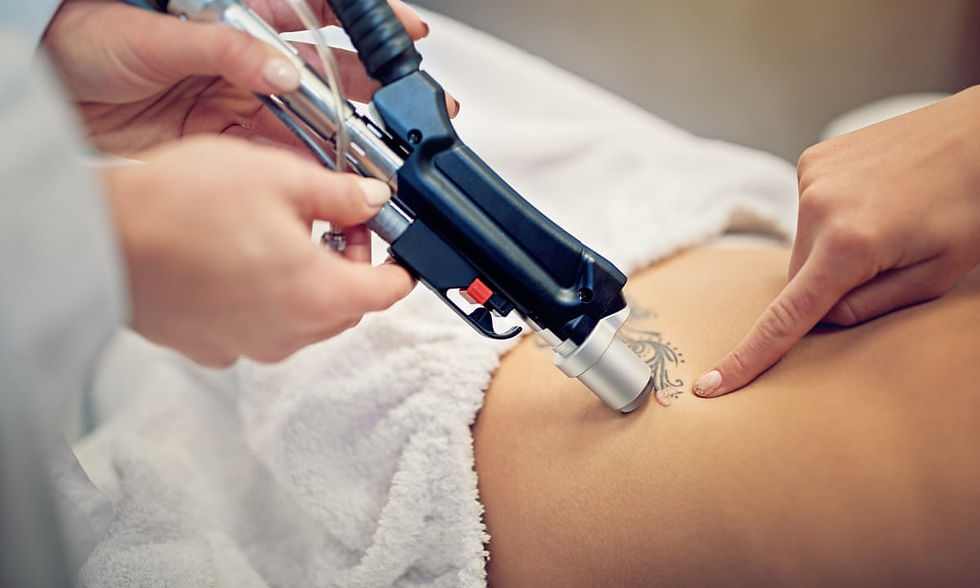The Evolution of Laser Tattoo Removal Technology
- danyalmalikdynamic
- Sep 19, 2024
- 4 min read
Tattoo removal has undergone significant advancements over the years, evolving from rudimentary methods to highly sophisticated laser technologies. This evolution has made tattoo removal more efficient, less painful, and accessible to a broader range of people. In this article, we will explore the history and advancements in laser Tattoo Removal in Dubai technology, focusing on how these developments have improved the process.
Early Methods of Tattoo Removal
Before the advent of laser technology, removing a tattoo was a challenging and often painful process. Early methods included:
Surgical Excision
One of the oldest techniques for tattoo removal is surgical excision. This method involves cutting out the tattooed skin and stitching the remaining skin back together. While effective in removing tattoos, this approach often results in scarring and is typically reserved for smaller tattoos.

Dermabrasion
Dermabrasion is another early method where the outer layers of the skin are mechanically removed using a rotating abrasive device. This process can be quite painful and is generally used for tattoos that are not too deeply embedded in the skin. Although it can be effective, it also carries a risk of scarring and uneven skin texture.
Chemical Peels
Chemical peels involve applying a chemical solution to the tattooed area to remove the outer layers of skin. While this method can help in fading tattoos, it often requires multiple sessions and may not completely remove the tattoo. Additionally, it can cause irritation and discomfort.
The Advent of Laser Tattoo Removal
The introduction of laser technology revolutionized tattoo removal. Unlike traditional methods, lasers target the pigment in the tattoo without affecting the surrounding skin. Here are some key milestones in the evolution of laser tattoo removal:
Early Laser Systems
The earliest laser systems used for tattoo removal were the Q-switched lasers. These lasers work by emitting short bursts of high-intensity light that break up the tattoo ink particles. The fragmented ink is then gradually removed by the body's immune system. While Q-switched lasers represented a significant advancement, they had limitations in treating all ink colors and types of tattoos.
Advancements in Laser Technology
Over time, laser technology continued to improve, leading to more effective and efficient treatments. Some key advancements include:
Multi-Wavelength Lasers
Multi-wavelength lasers have been developed to address the limitations of early Q-switched lasers. These systems use different wavelengths of light to target a broader range of ink colors, making it possible to treat more diverse tattoos. For instance, the introduction of the Nd
laser allowed for better treatment of darker ink colors, such as black and blue.
PicoSure and PicoWay Lasers
The development of picosecond lasers, such as PicoSure and PicoWay, marked another significant advancement. Unlike traditional lasers that emit light in nanoseconds, picosecond lasers deliver light in trillionths of a second. This ultra-short pulse duration helps to break up tattoo ink particles into even smaller fragments, leading to more efficient removal and faster treatment times. Additionally, these lasers are known for causing less thermal damage to the skin, resulting in reduced risk of scarring.
Innovations in Tattoo Removal Technology
Recent innovations in laser tattoo removal technology have further enhanced the process, making it more effective and comfortable for patients.
Combination Therapies
Combination therapies involve using different types of lasers in conjunction to achieve better results. For example, combining Q-switched lasers with picosecond lasers can target both superficial and deeper ink layers, improving overall tattoo removal effectiveness. This approach can also minimize the number of sessions required to achieve desired results.
Advanced Cooling Systems
To address the discomfort associated with laser tattoo removal, advanced cooling systems have been integrated into laser devices. These systems help to cool the skin during treatment, reducing pain and improving patient comfort. Techniques such as cryogen sprays and built-in cooling mechanisms have become standard features in modern laser systems.
Personalized Treatment Plans
Modern laser tattoo removal practices emphasize personalized treatment plans tailored to individual needs. Factors such as tattoo size, color, and location are considered when developing a treatment plan. This personalized approach ensures that each patient receives the most effective and appropriate treatment for their specific tattoo.
Tattoo Removal in Dubai
In Dubai, the demand for tattoo removal has seen a significant increase, reflecting the growing awareness of advanced treatment options available in the region. Clinics in Dubai are equipped with state-of-the-art laser technology, including multi-wavelength and picosecond lasers, providing residents with access to cutting-edge tattoo removal treatments.
Dubai's focus on providing high-quality healthcare services has led to the adoption of the latest innovations in laser technology. Patients seeking tattoo removal in Dubai can benefit from the expertise of skilled practitioners and advanced equipment, ensuring optimal results and a comfortable experience.
The evolution of laser tattoo removal technology has transformed the tattoo removal process from a painful and often ineffective procedure to a highly refined and efficient treatment. Advances such as multi-wavelength lasers, picosecond technology, and personalized treatment plans have significantly improved the effectiveness and comfort of tattoo removal. In Dubai, residents have access to some of the most advanced tattoo removal technologies available, making it easier than ever to achieve clear and tattoo-free skin. As technology continues to advance, it is likely that tattoo removal will become even more effective and accessible in the future.
Comments